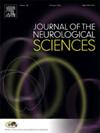脑脊液腺苷脱氨酶水平升高引起的一系列神经系统疾病。
IF 3.2
3区 医学
Q1 CLINICAL NEUROLOGY
引用次数: 0
摘要
目的:研究脑脊液(CSF)腺苷脱氨酶(ADA)在各种神经系统疾病中的水平,并探讨其与免疫参数的关系。方法:对276例疑似结核性脑膜炎(TBM)的CSF ADA水平进行评估。收集基线特征、最终诊断、CSF ADA水平和其他实验室参数的数据。然后根据最终诊断比较脑脊液ADA水平,并评估脑脊液ADA水平与其他脑脊液和血液实验室参数的相关性。结果:与非炎症性疾病对照组(n = 40)相比,5种疾病的脑脊液ADA水平显著升高:(1)TBM (n = 15, p = 0.7566, p = 0.6693, p = 0.6452, p = 0.6035, p = 0.6334, p = 0.5954, p)讨论:各种炎症性神经系统疾病的脑脊液ADA水平均升高,尤其是TBM、真菌性脑膜炎、GFAP-A、神经结节病和淋巴细胞增生性疾病。CSF ADA水平可能反映中枢神经系统t细胞过度活化。本文章由计算机程序翻译,如有差异,请以英文原文为准。
A spectrum of neurological diseases with elevated cerebrospinal fluid adenosine deaminase levels
Objectives
This study aimed to investigate cerebrospinal fluid (CSF) adenosine deaminase (ADA) levels in various neurological disorders and examine the relationships between CSF ADA levels and immunological parameters.
Methods
Overall, 276 patients whose CSF ADA levels were measured for suspected tuberculous meningitis (TBM) were evaluated. Data on baseline characteristics, final diagnoses, CSF ADA levels, and other laboratory parameters were collected. Thereafter, CSF ADA levels were compared based on final diagnoses, and correlations between CSF ADA levels and other CSF and blood laboratory parameters were evaluated.
Results
Five diseases exhibited a significant increase in CSF ADA levels relative to the noninflammatory disease control group (n = 40): (1) TBM (n = 15, p < 0.0001), (2) fungal meningitis (n = 7, p = 0.0400), (3) autoimmune glial fibrillary acidic protein astrocytopathy (GFAP-A, n = 7, p < 0.0001), (4) neurosarcoidosis (n = 7, p = 0.0028), and (5) lymphoproliferative disorders (n = 18, p = 0.0001). Strong positive correlations were observed between CSF ADA and CSF parameters, including soluble IL2 receptor (rs = 0.7566, p < 0.0001), albumin (rs = 0.6693, p < 0.0001), lactate dehydrogenase (rs = 0.6452, p < 0.0001), white blood cell count (rs = 0.6035, p < 0.0001), protein (rs = 0.6334, p < 0.0001), and lymphocytes (rs = 0.5954, p < 0.0001).
Discussion
CSF ADA levels were elevated in various inflammatory neurological diseases, especially in TBM, fungal meningitis, GFAP-A, neurosarcoidosis, and lymphoproliferative disorders. CSF ADA levels may reflect T-cell hyperactivation in the central nervous system.
求助全文
通过发布文献求助,成功后即可免费获取论文全文。
去求助
来源期刊

Journal of the Neurological Sciences
医学-临床神经学
CiteScore
7.60
自引率
2.30%
发文量
313
审稿时长
22 days
期刊介绍:
The Journal of the Neurological Sciences provides a medium for the prompt publication of original articles in neurology and neuroscience from around the world. JNS places special emphasis on articles that: 1) provide guidance to clinicians around the world (Best Practices, Global Neurology); 2) report cutting-edge science related to neurology (Basic and Translational Sciences); 3) educate readers about relevant and practical clinical outcomes in neurology (Outcomes Research); and 4) summarize or editorialize the current state of the literature (Reviews, Commentaries, and Editorials).
JNS accepts most types of manuscripts for consideration including original research papers, short communications, reviews, book reviews, letters to the Editor, opinions and editorials. Topics considered will be from neurology-related fields that are of interest to practicing physicians around the world. Examples include neuromuscular diseases, demyelination, atrophies, dementia, neoplasms, infections, epilepsies, disturbances of consciousness, stroke and cerebral circulation, growth and development, plasticity and intermediary metabolism.
 求助内容:
求助内容: 应助结果提醒方式:
应助结果提醒方式:


